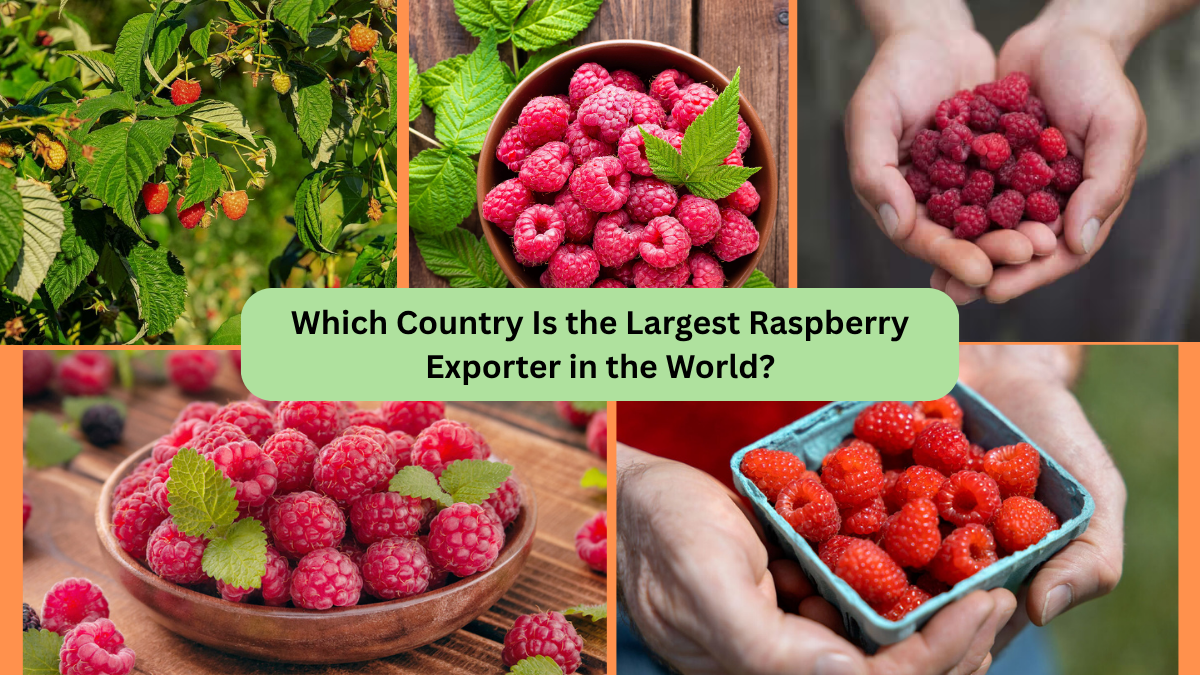Raspberries are among the most prized fruits globally, known for their vibrant red color, delicate texture, and rich, sweet-tart flavor. Whether enjoyed fresh in summer desserts or frozen for use in smoothies and baking, raspberries have seen their popularity surge worldwide. As a result, global raspberry production and trade have expanded rapidly over the past two decades.
But which country currently holds the title of the largest raspberry exporter in the world? The answer may surprise you, as it reflects the shifting dynamics of international berry trade and the rise of new exporting powerhouses.
A Look at the Global Raspberry Market

Raspberry production has traditionally been dominated by countries in Europe and North America, but recent years have seen emerging economies expand their cultivation and export capacity. Raspberries are highly perishable, requiring swift and careful handling to reach markets fresh. To overcome this, much of the global trade also involves frozen raspberries, which maintain quality during long-distance shipping.
The international raspberry trade is typically divided into two categories:
- Fresh Raspberries (high value, sold in-season)
- Frozen Raspberries (used in food processing, smoothies, desserts)
According to FAO and international trade data, global raspberry production reached nearly 950,000 metric tons in 2022, with both fresh and frozen exports increasing steadily year after year.
The Largest Raspberry Exporter: Ukraine Takes the Lead
As of 2024, Ukraine has emerged as the largest raspberry exporter in the world, particularly in the frozen raspberry segment — which represents the bulk of international raspberry trade.
Ukraine’s Export Milestone
In 2023-2024:
- Ukraine exported over 65,000 metric tons of frozen raspberries
- This marked a 34% increase over the previous year
- Ukraine overtook traditional leaders like Serbia and Poland to become the top frozen raspberry exporter globally
This is a remarkable achievement considering the challenges posed by regional conflicts and trade disruptions. Ukraine’s berry industry has not only proven resilient but strategically agile, swiftly adjusting export routes and expanding into new markets.
Why Ukraine Leads the Raspberry Export Market

Several factors explain Ukraine’s rapid rise to the top of the raspberry export rankings:
Ideal Growing Conditions
Ukraine’s fertile soil, temperate climate, and long growing season make it perfect for berry cultivation. The country has seen a sharp rise in raspberry production since the early 2000s, with thousands of small and mid-sized farms specializing in berry crops.
Investment in Cold Chain and Processing
One of the biggest contributors to Ukraine’s export success has been significant investment in cold chain logistics and freezing infrastructure. This has allowed producers to maintain high product quality for frozen raspberries destined for export markets in Europe, North America, and beyond.
Focus on Export Markets
Unlike Poland and Serbia, which export a large portion of their raspberries indirectly via re-export markets, Ukraine exports most of its raspberries directly. This export-focused strategy has made Ukrainian raspberries highly competitive in terms of both quality and pricing.
Market Diversification
Faced with trade tensions in neighboring Poland, Ukraine successfully diversified its export destinations to countries like Germany, France, the United States, Canada, the United Kingdom, and Saudi Arabia. In just three years, the proportion of raspberries exported to Poland dropped from 63% to 35%, reducing dependency and strengthening Ukraine’s market presence worldwide.
Other Major Raspberry Exporters

While Ukraine has recently claimed the top spot in frozen raspberry exports, several other countries remain important players in both fresh and frozen raspberry trade.
Serbia
Serbia has long been one of the world’s leading frozen raspberry exporters. In 2023-2024, Serbia exported around 63,000 metric tons of frozen raspberries. Although slightly behind Ukraine in net export volume, Serbia continues to be a key supplier, especially for European markets.
Poland
Poland remains a major player, exporting over 16,000 metric tons of frozen raspberries in 2024. However, its export volumes have declined in recent years, largely due to increased competition and shifting trade dynamics in Eastern Europe.
Mexico
Mexico dominates the fresh raspberry export market, exporting around 112,000 metric tons of fresh raspberries annually. Its proximity to the United States — one of the world’s largest raspberry consumers — gives Mexico a significant logistical advantage, particularly for delivering fresh fruit quickly.
Spain
Spain is another important exporter of fresh raspberries, with around 75,000 metric tons exported annually. The country primarily serves European markets, especially the United Kingdom, Germany, and France.
Morocco
Morocco’s raspberry industry has experienced rapid growth in the last decade, exporting over 56,000 metric tons of fresh raspberries annually. The country has become the second-largest fresh raspberry supplier to the UK market and continues to expand its presence across Europe.
2024 Raspberry Export Rankings (Frozen)
| Rank | Country | Export Volume (Metric Tons) | Market Focus |
|---|---|---|---|
| 1 | Ukraine | 65,000 | Europe, North America, Middle East |
| 2 | Serbia | 63,000 | Europe |
| 3 | Poland | 16,000 | Europe |
| 4 | Chile | ~700 (data fluctuates) | Americas |
| 5 | Morocco | Growing rapidly | Europe |
Trends in the Global Raspberry Market

Several key trends are shaping the future of global raspberry exports:
Rising Demand for Frozen Berries
The frozen fruit market is experiencing unprecedented growth, driven by rising consumer demand for health-focused, convenient products like smoothies, yogurt toppings, and healthy snacks. Frozen raspberries, with their high antioxidant content and long shelf life, are a perfect fit.
Cold Chain Logistics Expansion
Advancements in refrigeration technology and cold storage infrastructure have made it easier for countries like Ukraine to export raspberries over long distances while preserving quality.
Market Diversification
Exporters are increasingly looking to expand beyond traditional European markets into North America, the Middle East, and Asia. This trend reduces trade risks and opens up new opportunities for growth.
Sustainability and Organic Certification
As consumers become more health and environmentally conscious, demand for organic and sustainably grown raspberries is rising. Exporters that can meet these standards are likely to command premium prices in global markets.
Future Outlook for the Raspberry Export Market

The global raspberry export market is expected to continue growing in the coming years, with several factors contributing to its expansion:
- Increasing consumer awareness of the health benefits of berries
- Growing demand for frozen berries in food service and retail sectors
- Rising popularity of smoothies, desserts, and health snacks worldwide
- Advances in agricultural technology, enabling higher yields and better quality
Ukraine is likely to retain its position as the largest frozen raspberry exporter, while countries like Mexico, Morocco, and Spain will continue to lead in the fresh raspberry segment.
Final Thoughts
To summarize:
- Ukraine is currently the largest raspberry exporter in the world in the frozen category, having overtaken traditional leaders like Serbia and Poland.
- Its rapid rise is driven by ideal growing conditions, strong investment in cold chain logistics, an export-focused strategy, and successful market diversification.
- Other important players include Serbia, Poland, Mexico, Spain, and Morocco, each with their unique strengths in fresh or frozen raspberry exports.
- As global demand for both fresh and frozen raspberries continues to grow, these countries are likely to remain vital to the international berry trade.
The raspberry export industry, once dominated by a handful of European countries, is now a dynamic, global market — and Ukraine’s recent ascent to the top is a testament to how smart investment and resilience can reshape international trade.





